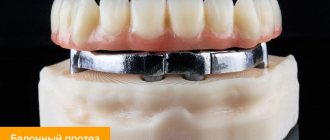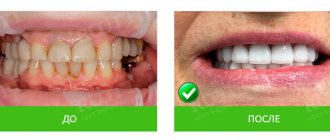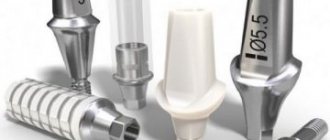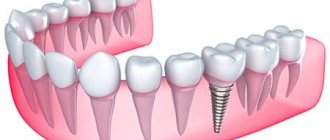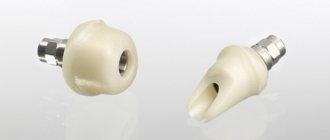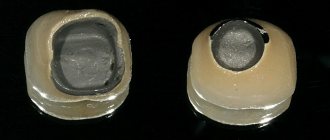Installation of ultranir in 3 stages
In order to install ultraneers, two visits to the dentist and three technological stages are enough.
Stage 1.
At the first appointment, the doctor will determine the possibility of installing thin ceramic onlays and assess the amount of work. If you have no problems with the health of your teeth and oral cavity, as well as contraindications to the procedure, the specialist will begin making an impression of your dentition.
Stage 2.
Ultraneers will be made for you in the laboratory on the dental impression of the latter within 1 – 2 weeks.
Stage 3.
The second visit to the dental office coincides with the time when the ceramic onlays are ready. First, the doctor will carry out professional teeth cleaning to remove plaque and tartar, preventing the formation of caries under the veneers, and then fix the ultraneers on the outside of the teeth in the smile area using a special composition. Polishing ceramic overlays is the final stage of the procedure.
Operational period
IPS e max ceramics are unique in their kind because, with a thickness of 0.3 mm, they can withstand loads of up to 400 MPa. For comparison, Cerinate (Lumineers) - up to 110 MPa.
The metal-free structure obtained by pressing is completely homogeneous, which means it can not change color for more than 10 years.
When manufactured correctly, ultranir should adhere to the tooth as much as possible, which will ensure its long-term fixation and protect the tooth from external factors.
Taking into account all these properties and the correct implementation of the manufacturing process, ultraneers can last from 10 to 15 years.
Advantages and disadvantages of ultranir
Installing ultraneers can be beneficial for a number of reasons, but it is worth installing the onlays taking into account the recommendations of your doctor. In the table below, Startsmile compared all the pros and cons of ultranir.
- Installation of ultraneers is quick and painless.
In Russian laboratories, ultraneers are produced in 7–14 days, while the production of lumineers requires additional time (up to 30 days) to ship finished structures from the USA. Installation of ceramic plates does not cause discomfort - the procedure is painless. - Partial restoration available.
If your goal is to improve the appearance of 1-2 teeth, installing ultraneers will be the ideal solution, while the use of lumineers is only relevant when restoring the entire smile area. This is due to the fact that ultraneers are more transparent than lumineers and are closer to the natural color of teeth, although they give them a lighter shade. - You can always remove ultraneers.
The procedure takes little time and does not damage tooth enamel. - Affordable price.
No damage to the enamel if the patient wants to return the teeth to their original state.
- Ceramic linings require careful handling and care.
The downside of ultraneers is that you will have to stop eating solid foods (nuts, crackers, seeds) and eat raw fruits and vegetables with caution. Otherwise, the records may crack. Do not forget about regular brushing of your teeth twice a day, as well as the need to use dental floss and an irrigator, cleaning the gingival folds and the space between the teeth. - Ultraneers do not correct serious dental defects.
If you have severely crooked teeth, large chips, or thinned tooth enamel, applying ceramic onlays will not help the situation. In addition, ultraneers are attached to the teeth in the smile zone, which means they can correct minor defects only in the front teeth. - The procedure may be prohibited.
If you have diseases of the teeth or oral cavity (for example, gingivitis, periodontitis and others), then ultraneers are contraindicated for you.
What is the difference with veneers
For easy comparison of products, the table shows the main indicators of popular dental onlays, their manufacturing method, material and service life.
| Product | Material | Thickness | Enamel preparation | Preparation method | Life time | Approximate cost (RUB) |
| Veneers | Composites Porcelain Ceramics | 0.5—1.5 mm | Yes | In the oral cavity (one day) Laboratory (2-5 days) | 5-7 years | 5-20 thousand |
| Ultraneers | IPS emax ceramics | 0.3—0.4 mm | No | Laboratory (7-10 days) | 7-15 years | 20-35 thousand |
| Lumineers | Ceramic Ceramics | Less than 0.3mm | No | Laboratory (from 15-30 days) | 12-20 years | 35-50 thousand |
Another important difference is the reversibility of the ultranir installation process. That is, if desired, the veneers can be removed, exposing your teeth.
This will not be possible with veneers, since the tooth will be ground down and without a protective lining, it will no longer be able to exist.
Ultraneers - price in Moscow for 1 tooth
The cost of one ceramic onlay depends on the level of the clinic performing ultraneers and the qualifications of the doctor. On average, for a plate for 1 tooth (each ultraneer is made separately) in Moscow you will have to pay 20 - 25 thousand rubles, and ultraneers will cost you less than lumineers and, as a rule, more expensive than veneers. If the clinic offers you ceramic onlays for much less than 20 thousand rubles, this may indicate low quality of the material or insufficient experience of the specialist.
Publisher: Expert magazine about dentistry Startsmile.ru
Author of the material: Yulia Usacheva
What are ultranir?
Ultraneers are ultra-thin veneers, that is, ceramic plates installed on the upper and lower front teeth to correct their shape and color. In addition to the straightening and whitening effect, ultraneers provide teeth with additional protection from negative external influences - mechanical, bacterial and chemical. The thickness of such onlays is in the range of 0.2-0.3 mm, which makes them completely invisible and cannot be distinguished from real teeth.
After installing ultraneers, the patient at the dental clinic feels comfortable, since these microprostheses practically “merge” with the teeth, and wearing them does not cause addiction. They can be removed at any time and replaced with linings of any other type.
Installation process
Choosing a color
To install ultraneers, you will need to visit the dental clinic twice and go through several stages of the procedure. These dental plates are made quickly, so no more than 8-12 days will pass between your first visit to the dentist and the achievement of a beautiful smile. The process for installing ultra-thin veneers is as follows.
- The dentist assesses the condition of the patient’s teeth and the amount of work to be done. If you have problems with the health of your teeth or gums, you will need to undergo treatment and only then begin to correct your smile. If everything is in order, the doctor sanitizes the oral cavity and prepares the teeth for further procedures.
- Then the doctor grinds the tooth enamel under local anesthesia. In this case, only a small part of it is removed from the surface of the teeth (up to 0.3 mm), because this method does not require significant preparation. In some cases, turning is not needed at all.
- Next, impressions are made of all teeth on which ultraneers will be fixed. If there has been preparation, temporary microprostheses made of plastic are installed for the patient’s comfort. In the absence of grinding, the client of the dental clinic simply leaves it after taking impressions and waits for a call from the dentist.
- Ultraneers are manufactured within 1-1.5 weeks, after which the patient visits the dentist again. Temporary onlays are removed (if any), and the doctor fixes permanent ultra-thin veneers onto the surface of the teeth using dental glue. Before installing the plates, the teeth are thoroughly cleaned of plaque and treated with a special solution.
- The ultraneers are then thoroughly sanded and polished to achieve the most natural appearance possible.
- At the final stage of the procedure, the microprostheses are checked for comfort. If the patient is comfortable, the installation of the onlays is considered complete. At the slightest feeling of discomfort, the dentist makes additional adjustments to the ultranir.
Lumineers or Ultraneers?
Indications for microprosthetics with ultranir
With the help of ultraneers, you can restore the aesthetics and whiteness of your smile, adjust the size and shape of your teeth, and also hide visible imperfections, such as:
- chips and cracks in enamel;
- “dullness” and discoloration after depulpation (nerve removal);
- yellowness caused by smoking or drinking tea and coffee;
- fillings on the front teeth;
- fissures and diastemas;
- slight curvature, “small” and “sharp” teeth.
The procedure for microprosthetics with ultranir is absolutely painless: the layer of ceramic that covers the teeth does not exceed the thickness of a contact lens. Therefore, there is no need for grinding and preparation by preparation: a special composite is applied to the front surface of the teeth, after which ultraneers are put on them.
Indications and contraindications for use
Installing ultraneers on teeth restores the beauty and aesthetics of a smile, returns a healthy light shade of enamel, and also corrects the size and shape of teeth. Carrying out this procedure is not a whim of the patient, because there are corresponding indications for it:
- discoloration of tooth enamel caused by tobacco smoking, excessive coffee consumption, chronic intoxication and other reasons;
- loss of enamel color after removal of nerves in teeth;
- cracks, chips and other damage to the integrity of the tooth acquired due to injury or tissue damage by chemical compounds;
- minor curvature of teeth;
- pathological wear of enamel;
- gaps between the front teeth;
- the presence of fillings on the front teeth.
Like any medical procedure, the installation of ultraneers has its own contraindications, which include:
- serious malocclusion;
- general weakening of teeth;
- thinning of enamel;
- bruxism (involuntary grinding of teeth);
- extreme sports with the risk of jaw injury;
- presence of dental diseases (periodontal disease, caries, etc.)
Attention! If the patient has inflammatory processes in the oral cavity, it is imperative to eliminate them before correcting teeth with ultraneers. Microprostheses are installed only on completely healthy teeth.
Before and after installing ultranir
Ultraneers
Ultraneers are thin (0.3 - 0.5 mm) plates that have become a worthy response of Russian scientists to the invasion of lumineers on the domestic market. Ultraneers are rightly called analogues of American Lumineers, but they are made within the Russian Federation from ultra-strong IPS e.max ceramics, so the cost of the records is not too expensive. When installing lumineers, the price per tooth is significantly higher. Installation requires virtually no preliminary preparation in the form of grinding the enamel.
The Emax material used for ultraneers is inferior in strength to the lithium disilicate from which Luxneers are made. This means that luxneers are the best alternative to all options: install veneers without tooth preparation on the front teeth.
Contraindications for veneers and lumineers
It is not recommended to install veneers or lumineers on teeth if you have caries, gum problems, thin enamel, or malocclusion. It is necessary to restore all damaged teeth and eliminate all defects before the procedure begins.
Characteristics of veneers and lumineers:
- The thickness of lumineer and ultraneer is 0.3 mm. Veneers have more – 0.5-.75 mm;
- the cost of lumineers and ultraneers is several times more expensive than the installation of veneers;
- The warranty period for microprostheses is on average 10 years.
Technology for making veneers and ultraneer:
- initial examination, approval of the appearance of the prostheses (color, size, shape);
- grinding down tooth enamel to the size of the microprosthesis being installed. This will allow him to look natural in the future;
- production of ceramic plate;
- installation of the plate on a cement base.
Lumineers manufacturing technology:
- create an accurate impression of your natural teeth;
- production of lumineers of the appropriate shape and required color;
- are placed on top of natural teeth;
- installation on a cement base.
